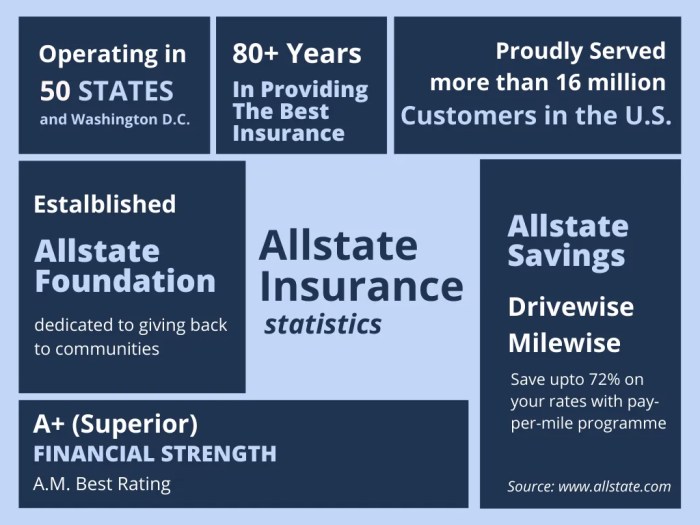Allstate insurance raising rates – Allstate, one of the nation’s largest insurance providers, recently announced rate increases impacting numerous policyholders. These increases have sparked considerable concern and questions among consumers. This comprehensive guide aims to provide clarity on the reasons behind these hikes, their potential impact, and what policyholders can do to navigate this challenging situation. We will delve into the specifics, exploring the factors contributing to the rise in premiums, examining the variations across different states and policy types, and offering actionable advice for consumers.
Understanding Allstate’s Rate Increases
Allstate’s rate adjustments aren’t a singular event; they reflect broader trends within the insurance industry. Several key factors contribute to these increases, creating a complex interplay that affects premiums across the board. Let’s explore some of the most significant influences:
Rising Costs of Claims
One of the most prominent drivers of increased insurance premiums is the escalating cost of settling claims. This is influenced by several factors: inflation, which increases the price of repairs and replacements; the rising cost of medical care, particularly for injuries sustained in accidents; and an increase in the frequency and severity of certain types of claims, such as those involving weather-related damage or vehicle collisions.

Source: agencyheight.com
Increased Litigation Costs, Allstate insurance raising rates
The legal landscape surrounding insurance claims has become increasingly complex and costly. Higher legal fees, longer litigation processes, and larger jury awards all contribute to the overall expense of handling claims, ultimately impacting premium rates. This trend is particularly noticeable in certain states with higher rates of litigation.

Source: keymedia.com
Inflation and Economic Factors
Broad economic factors play a significant role. Inflation affects the cost of everything from car parts to medical services. Economic downturns can also influence claims frequency as people drive more to find work or cut back on preventative maintenance. These interconnected factors create a ripple effect that impacts insurance pricing.
Catastrophic Events and Natural Disasters
The increasing frequency and severity of catastrophic events, such as hurricanes, wildfires, and floods, significantly impact insurance premiums. Insurers must account for the increased risk of paying out large claims due to these events, leading to higher premiums in affected areas. This is particularly true in regions prone to natural disasters.
Changes in State Regulations
State regulations also play a part. Changes in state laws concerning insurance coverage, claims handling, or consumer protection can influence how insurers operate and, consequently, the cost of insurance. These regulatory shifts can vary significantly from state to state, leading to differing premium increases across the country.
How Allstate Rate Increases Vary
It’s crucial to understand that Allstate’s rate increases aren’t uniform across the board. Several factors influence the extent of the increase for individual policyholders:
Location
Geographic location is a major determinant. Areas with higher risks (e.g., those prone to natural disasters or with higher crime rates) generally experience larger premium increases than lower-risk areas. This reflects the increased likelihood of claims in high-risk zones.
Type of Insurance
The type of insurance policy also impacts the rate increase. Auto insurance premiums might rise differently than homeowners insurance, reflecting varying claim costs and risk profiles associated with each type of coverage.
Driving Record and Credit Score
Individual risk factors play a significant role. Policyholders with poor driving records or lower credit scores typically face higher premiums than those with clean records and good credit. These factors reflect the perceived risk associated with each individual policyholder.
What Policyholders Can Do: Allstate Insurance Raising Rates
Facing a premium increase can be frustrating, but there are steps policyholders can take to mitigate the impact:
- Shop Around: Compare quotes from other insurers to see if you can find a more competitive rate.
- Review Your Coverage: Ensure you’re not paying for unnecessary coverage. Consider adjusting your deductible to potentially lower your premium (though this increases your out-of-pocket expense in case of a claim).
- Improve Your Driving Record: Maintaining a clean driving record can significantly reduce your auto insurance premiums.
- Bundle Your Policies: Bundling your auto and homeowners insurance with the same provider often results in discounts.
- Explore Discounts: Inquire about available discounts, such as those for good students, safe drivers, or home security systems.
- Contact Allstate Directly: Reach out to Allstate to discuss your options and explore potential payment plans or other solutions.
Frequently Asked Questions (FAQs)
- Q: Why are my Allstate rates increasing? A: Several factors contribute, including rising claim costs, increased litigation, inflation, and catastrophic events. The specific reasons for your increase may vary based on your location, policy type, and individual risk profile.
- Q: How much will my Allstate rates increase? A: The amount of the increase varies significantly depending on your location, policy type, and risk profile. You should receive a notification from Allstate detailing the specific increase for your policy.
- Q: Can I cancel my Allstate policy? A: Yes, you can cancel your policy at any time, but you may be subject to cancellation fees or penalties depending on your policy terms.
- Q: What other insurance companies can I compare Allstate to? A: Consider comparing rates with other major insurers like State Farm, Geico, Progressive, and Nationwide. It’s always advisable to obtain multiple quotes.
- Q: How can I appeal my rate increase? A: Review your policy documents and contact Allstate directly to discuss your concerns and explore options. You may be able to negotiate or provide additional information to potentially influence your rate.
Resources
- Allstate Website (Official website for policy information)
- Insurance Information Institute (Provides industry insights and consumer resources)
- [Add other relevant links to insurance comparison websites or consumer protection agencies]
Call to Action
Don’t hesitate to take control of your insurance costs. Compare rates, review your coverage, and explore all available options to find the best insurance solution for your needs. Contact Allstate directly to discuss your specific situation and explore potential solutions. Proactive planning can help you navigate these challenging times and ensure you have the appropriate insurance coverage.
Questions Often Asked
What specific factors are causing Allstate to raise rates?
Several factors contribute, including increased claim costs due to higher repair expenses and more frequent severe weather events, inflation impacting operational expenses, and changes in state regulations.
How much will my Allstate insurance rates increase?

Source: johnsonalday.com
The increase varies depending on your location, coverage type, and driving history. Contact Allstate directly for details on your specific policy adjustment.
Can I appeal my Allstate rate increase?
Yes, you can contact Allstate to review your policy and discuss potential options, such as increasing your deductible or exploring different coverage levels.
What alternatives are there to Allstate insurance?
Several other insurance providers offer similar coverage. It’s advisable to compare quotes from multiple companies to find the most competitive rates and coverage options.
